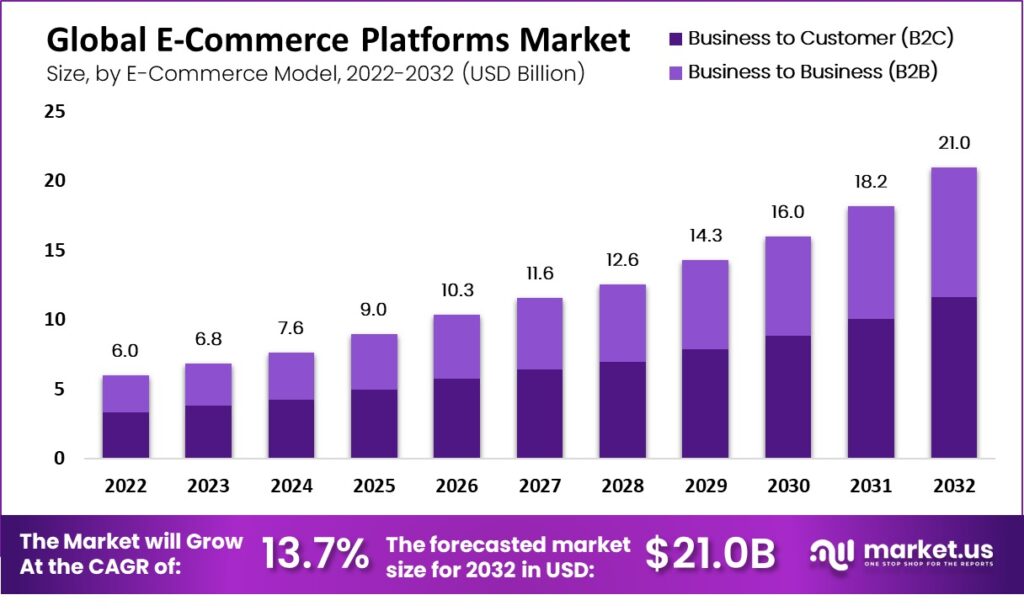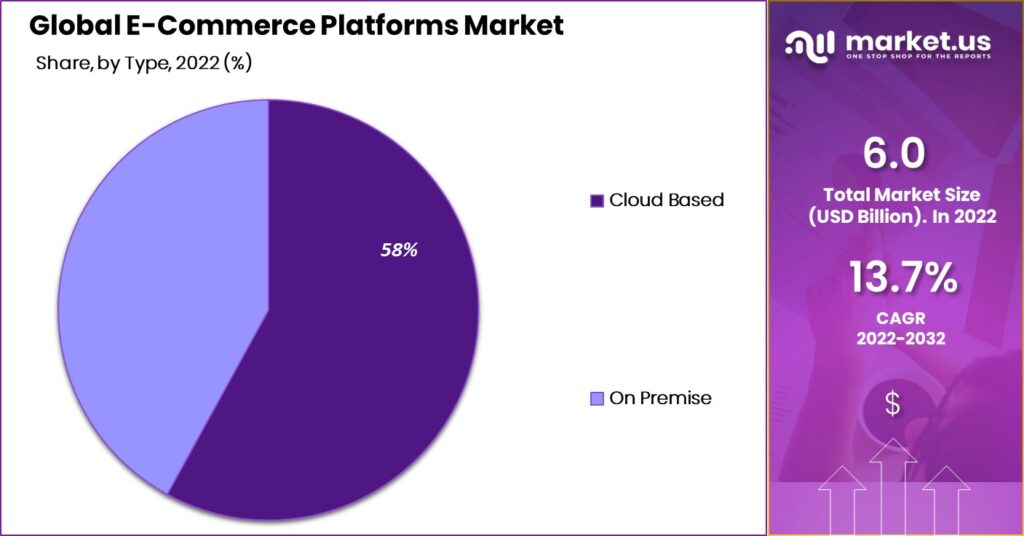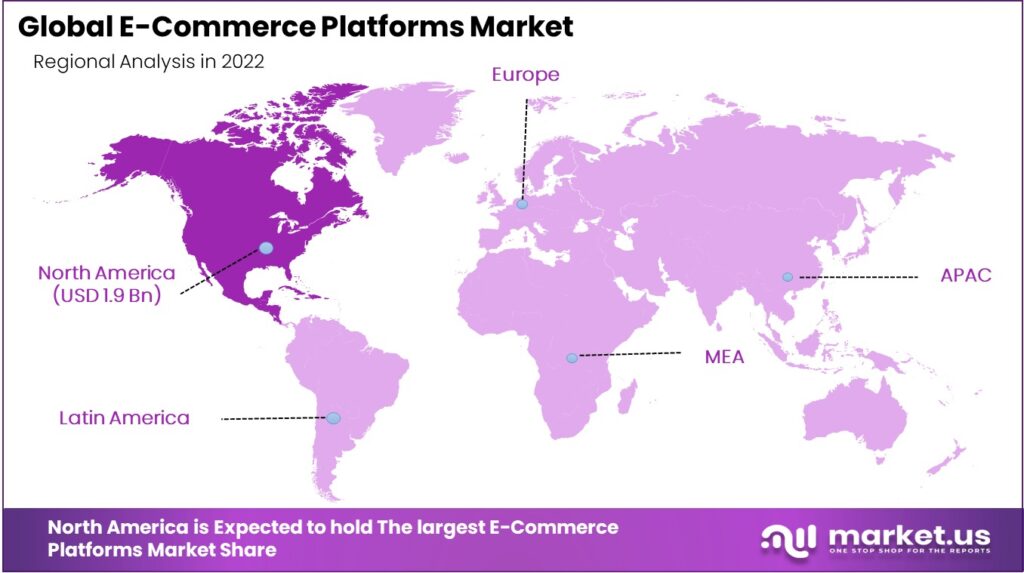Global E-Commerce Platforms Market By E-Commerce Model (Business to Business and Business to Customer), By Type (Cloud Based and On-Premise), and By Application (Fashion & Apparel, Electrical & Electronics, Food & Beverage, Health & Beauty, Other Applications), By Region and Companies - Industry Segment Outlook, Market Assessment, Competition Scenario, Trends, and Forecast 2023-2032
- Published date: Jan. 2024
- Report ID: 53872
- Number of Pages: 320
- Format:
- keyboard_arrow_up
Quick Navigation
Report Overview
The Global E-Commerce Platforms Market in terms of revenue was estimated to be worth USD 6.8 Bn in 2023 and is poised to reach USD 21.0 Bn by 2032, growing at a CAGR of 13.7% from 2023 to 2032.
E-commerce platforms have revolutionized the way businesses operate and consumers shop by providing a digital infrastructure that enables online transactions, product management, and customer engagement. These platforms serve as the foundation for building and managing online stores, facilitating the buying and selling of goods and services over the internet. The e-commerce platforms market refers to the industry encompassing the development, distribution, and support of these software solutions for businesses of all sizes.
In recent years, the e-commerce platforms market has experienced remarkable growth, driven by several key factors. Firstly, the increasing consumer preference for online shopping and the convenience it offers have fueled the demand for robust e-commerce platforms. Consumers today expect seamless browsing, intuitive user interfaces, secure payment gateways, and personalized shopping experiences. E-commerce platforms provide businesses with the tools and features necessary to meet these evolving consumer expectations.

Secondly, the proliferation of mobile devices and the rise of mobile commerce (m-commerce) have significantly impacted the e-commerce platforms market. With the widespread adoption of smartphones and tablets, consumers can shop anytime and anywhere, leading to a surge in mobile transactions. E-commerce platforms have adapted to this trend by providing responsive designs and mobile-friendly interfaces to ensure a smooth shopping experience across devices.
Major players in the e-commerce market have established the standard for the domain by delivering comprehensive ecosystems that meet the requirements of businesses of all sizes. Small and large enterprises can create digital shops by adapting their branding and using data-driven insights to enhance their sales strategies. Moreover, the surge of mobile devices and the elevation of social media have also accelerated the e-commerce sector’s growth, owing to buyers increasingly leaning towards mobile shopping and finding products via social platforms.
Key Takeaways
- Market Growth: By 2032, it is projected that the E-Commerce Platforms Market will reach USD 21.0 Bn with compound annual compounding growth rate of 13.7% from USD 6.8 Bn in 2023.
- E-commerce Revolution: E-commerce platforms have revolutionized global business landscape, offering seamless transactions, personalized shopping experiences, and greater market penetration.
- Driving Factors: The market is driven primarily by high Internet penetration and smartphones that make online shopping accessible and convenient for consumers. Additionally, the user-friendly setup of e-commerce platforms has lowered barriers for small businesses, fostering market growth.
- Restraining Factors: Stringent regulatory frameworks and the threat of cyberattacks pose significant challenges for e-commerce platforms. Compliance with various legal frameworks and the need for advanced security measures to protect consumer data may impede market expansion.
- Dominant Segments: Business-to-customer (B2C) models lead the e-commerce platforms market, while cloud-based platforms dominate the segment, catering to a wide range of industries, with a significant share in the electrical & electronics application sector.
- Regional Insights: North America leads the global market, driven by the presence of major e-commerce companies, while Europe shows significant growth supported by government initiatives and regulations. The Asia Pacific region is expected to exhibit the fastest CAGR due to the rising adoption of online shopping in developing nations.
- Key Market Players: Shopify, eBay, Amazon, Oracle, SAP, Salesforce, Magento, Ecwid, OpenCart, and PrestaShop are among the top players in the e-commerce platforms market, focusing on technological advancements and strategic collaborations to strengthen their market position.
E-Commerce Model Analysis
In 2023, the Business to Customer (B2C) segment held a dominant market position in the e-commerce platforms market, capturing a significant share. The dominance of the B2C segment can be attributed to several key factors. Firstly, the rise of online retail and the increasing consumer preference for online shopping have propelled the growth of the B2C e-commerce model. Consumers today have easy access to a wide range of products and services from the comfort of their homes, leading to a surge in B2C e-commerce transactions.
Secondly, the B2C e-commerce model benefits from the sheer size of the consumer market. The broad customer base provides immense opportunities for businesses to reach and engage with a large number of individual buyers. E-commerce platforms catering to B2C transactions offer features and functionalities specifically designed to meet the demands and expectations of consumers, such as user-friendly interfaces, secure payment gateways, and personalized shopping experiences.
Furthermore, the convenience and flexibility offered by B2C e-commerce platforms have played a significant role in their dominance. Consumers can shop at any time, from anywhere, using various devices, including smartphones, tablets, and computers. B2C e-commerce platforms provide seamless browsing, product selection, and checkout processes, enhancing the overall shopping experience and convenience for consumers.
Type Analysis
In 2023, the Cloud-Based segment held a dominant market position in the e-commerce platforms market, capturing more than a 58% share.
The dominance of the Cloud-Based segment can be attributed to several key factors. Firstly, cloud-based e-commerce platforms offer significant advantages in terms of scalability and flexibility. Businesses can easily scale up or down their online operations based on demand, without the need for extensive infrastructure investments. Cloud-based platforms provide the necessary computing power, storage, and bandwidth on-demand, allowing businesses to efficiently handle peak periods and accommodate growth.
Secondly, the cost-effectiveness of cloud-based e-commerce platforms contributes to their dominance in the market. Compared to on-premise solutions, cloud-based platforms eliminate the need for businesses to invest in and maintain dedicated hardware, software licenses, and IT infrastructure. Instead, they can leverage a subscription-based model, paying for the resources and services they use. This cost-saving aspect makes cloud-based platforms an attractive option for businesses of all sizes, particularly small and medium-sized enterprises (SMEs) that may have budget constraints.
Furthermore, the accessibility and ease of deployment associated with cloud-based e-commerce platforms play a vital role in their dominance. Businesses can quickly set up and launch their online stores without the need for extensive technical expertise or lengthy implementation processes. Cloud-based platforms provide user-friendly interfaces and intuitive tools that enable businesses to manage their online operations effectively.
Moreover, the cloud-based model offers enhanced security and data protection measures. Reputable cloud service providers invest heavily in robust security protocols, encryption, and data backup mechanisms to ensure the integrity and confidentiality of customer and business data. This level of security assurance is particularly crucial for e-commerce platforms handling sensitive customer information and financial transactions.

Application Analysis
In 2023, the Electrical & Electronics segment held a dominant market position in the e-commerce platforms market, capturing a significant share.
The dominance of the Electrical & Electronics segment can be attributed to several key factors. Firstly, the increasing consumer demand for electrical and electronic products has driven the growth of the segment. The rapid advancements in technology, coupled with changing consumer lifestyles and preferences, have resulted in a surge in the online purchase of devices, gadgets, appliances, and other electronic goods. E-commerce platforms catering to the Electrical & Electronics segment provide a convenient and accessible platform for consumers to explore, compare, and purchase a wide range of products in this category.
Secondly, the nature of electrical and electronic products lends itself well to online sales. These products are typically well-suited for e-commerce due to their standardized specifications, clear product descriptions, and visual appeal. Consumers can easily browse through product catalogs, view images, read specifications, and make informed purchase decisions without the need for physical inspection.
Furthermore, the competitive pricing and discounts offered by e-commerce platforms in the Electrical & Electronics segment have contributed to their dominance. Online retailers and marketplaces often provide competitive pricing, special promotions, and exclusive deals on electrical and electronic products, attracting price-conscious consumers. This pricing advantage, coupled with the convenience of online shopping, has propelled the growth of the segment.
Moreover, the COVID-19 pandemic has further accelerated the dominance of the Electrical & Electronics segment. With increased remote work and learning arrangements, the demand for electronics such as laptops, tablets, and other home office equipment surged. Consumers turned to e-commerce platforms to fulfill their requirements, further driving the growth of the segment.
Key Market Segments
E-Commerce Model
- Business to Business (B2B)
- Business to Customer (B2C)
Type
- Cloud-Based
- On-Premise
Application
- Fashion & Apparel
- Electrical & Electronics
- Food & Beverage
- Health & Beauty
- Other Applications
Driving Factor
High Penetration of Internet and Smartphones is Driving the Growth of Global E-Commerce Platforms Market
The high internet connectivity and smartphone penetration has significantly expanded the e-commerce market. By making online shopping extremely accessible, many businesses and individuals found it easy and convenient to buy goods and services from e-commerce platforms without many inconveniences. Therefore, more and more individuals prefer to buy through e-commerce sites. This is boosting the growth of the global e-commerce platforms market.
Additionally, the user-friendly approach of various e-commerce platforms in setting up online stores has lowered the barriers for smaller businesses. These platforms provide adaptable templates, secure payment gateways, and tools for managing inventory, making it easier for enterprises to enter the digital marketplace easily. All these key factors are driving the growth of the global e-commerce platform market.
Restraining Factor
Stringent Regulatory Framework and Threat of Cyberattacks are Expected to Hinder the Growth of Global E-Commerce Market.
Many countries across the world have implemented various rules and regulations concerning online transactions, data privacy, and taxes. This creates a complex situation for e-commerce companies to navigate through various legal frameworks that could potentially affect their ability to grow in market.
Also, the concern over cybersecurity acts as another significant limitation for the e-commerce platform market. E-commerce platforms handle large amounts of sensitive consumer data and financial transactions that increases the risk of cyberattacks and data breaches. This requires high investments in advanced security measures to protect customer information and maintain their trust. These key factors are expected to restrain the growth of e-commerce platform market during the forecast period.
Growth Opportunity
Integration of Augmented Reality in Online Shopping is Expected to Create Many Lucrative Opportunities in the Global E-Commerce Platforms Market Over the Forecast Period.
As digital mediums gain widespread acceptance, consumers are actively leaning toward the convenience of online shopping. This is generating a growing demand for robust e-commerce platforms that cater to this trend. These platforms act as a gateway for businesses from small to large scale to establish their online presence more effectively and extend their market scope beyond geographical boundaries.
Moreover, many key companies in e-commerce platforms started to integrate augmented reality within the platform to offer immersive shopping encounters by refining personalized recommendations via machine learning and simplifying the checkout process using seamless payment gateways. These will enhance the experience of customers during the shopping. These key factors are anticipated to create many lucrative opportunities in the market during the forecast period.
Latest Trends
The rising Adoption of M-Commerce has Fueled the Growth of E-Commerce Platforms Market.
The e-commerce platforms market has undergone significant expansion and change in recent years. The proliferation of digital advancements and evolving consumer preferences have fueled this transformation for the e-commerce platform market.
The rapid adoption of mobile commerce (m-commerce) by consumers increasingly utilizing mobile devices for online shopping is pivotal in the growth of the e-commerce platforms market. This shift has forced e-commerce platforms to enhance their websites and create specialized mobile applications to enrich the shopping experience.
Regional Analysis
North America Leads the Global E-Commerce Platforms Market by Securing Major Revenue Share in Account.
The North America region leads the global e-commerce platforms market by holding a major revenue share of 32.8%. This growth of the North American region can be attributed to many companies offering e-commerce platforms in the United States. The United States is home to many major e-commerce companies in the world. The United States is also one of the biggest countries in the e-commerce market. According to reports, the United States accounts for around 20% of global sales through e-commerce platforms. These factor is driving the growth of the North America region in the global e-commerce platforms market.
After North America, Europe is the second largest global e-commerce platform market region. Supporting government initiatives and regulations is driving the growth of the e-commerce market in Europe. However, the Asia Pacific region is anticipated to grow at the fastest CAGR during the forecast period. Growing adoption of online shopping in developing nations across the Asia Pacific region is expected to drive the growth of the Asia Pacific region in the global e-commerce platforms market.

Key Regions and Countries Covered in this Report
- North America
- The US
- Canada
- Europe
- Germany
- France
- The UK
- Spain
- Italy
- Russia & CIS
- Rest of Europe
- APAC
- China
- Japan
- South Korea
- India
- ASIAN
- Rest of APAC
- Latin America
- Brazil
- Mexico
- Rest of Latin America
- Middle East & Africa
- GCC
- South Africa
- Rest of MEA
Key Player Analysis
The global e-commerce platforms market is fragmented into many key companies offering online shopping. However, key players like Shopify are trying to expand their business across regions by integrating advanced technology and customized software to enhance the user experience. Similarly, many key companies are adopting strategies like acquisition, collaboration, partnership, and mergers to expand their market share across various regions and strengthen their position in the market.
Top Key Players in E-Commerce Platforms Market
- Shopify
- eBay
- Amazon
- Oracle
- SAP
- Salesforce
- Magento
- Ecwid
- OpenCart
- PrestaShop
- Other Key Players
Recent Developments
- In January 2023, Shopify Introduced Commerce Components to enter its next era of growth by redefining enterprise retail.
- In February 2023, eBay Acquired 3 PM Shield to Bring Advanced Marketplace Compliance Technology In-House.
Report Scope
Report Features Description Market Value (2023) US$ 6.8 Bn Forecast Revenue (2032) US$ 21.0 Bn CAGR (2023-2032) 13.7% Base Year for Estimation 2023 Historic Period 2018-2022 Forecast Period 2023-2032 Report Coverage Revenue Forecast, Market Dynamics, COVID-19 Impact, Competitive Landscape, Recent Developments Segments Covered By E-Commerce Model – Business to Business and Business to Customer; By Type – Cloud Based and On Premise; and By Application – Fashion & Apparel, Electrical & Electronics, Food & Beverage, Health & Beauty, and Other Applications Regional Analysis North America – The US, Canada, & Mexico; Western Europe – Germany, France, The UK, Spain, Italy, Portugal, Ireland, Austria, Switzerland, Benelux, Nordic, & Rest of Western Europe; Eastern Europe – Russia, Poland, The Czech Republic, Greece, & Rest of Eastern Europe; APAC – China, Japan, South Korea, India, Australia & New Zealand, Indonesia, Malaysia, Philippines, Singapore, Thailand, Vietnam, & Rest of APAC; Latin America – Brazil, Colombia, Chile, Argentina, Costa Rica, & Rest of Latin America; Middle East & Africa – Algeria, Egypt, Israel, Kuwait, Nigeria, Saudi Arabia, South Africa, Turkey, United Arab Emirates, & Rest of MEA Competitive Landscape Shopify, eBay, Amazon, Oracle, SAP, Salesforce, Magento, Ecwid, OpenCart, PrestaShop, and Other Key Players Customization Scope Customization for segments, region/country-level will be provided. Moreover, additional customization can be done based on the requirements. Purchase Options We have three licenses to opt for Single User License, Multi-User License (Up to 5 Users), Corporate Use License (Unlimited User and Printable PDF) Frequently Asked Questions (FAQ)
What is the E-Commerce Platforms Market?The E-Commerce Platforms Market refers to the industry that provides software solutions and platforms for businesses to create, operate, and manage online stores and digital marketplaces. These platforms facilitate the buying and selling of goods and services over the internet.
Why are E-Commerce Platforms important?E-Commerce Platforms enable businesses to establish an online presence, reach a global audience, and streamline the process of selling products and services. They provide tools for inventory management, payment processing, customer engagement, and order fulfillment.
What features do E-Commerce Platforms offer?E-Commerce Platforms offer a range of features, including customizable website templates, product catalog management, secure payment gateways, shopping cart functionality, order tracking, customer reviews, analytics, and marketing tools.
Why is e-commerce platform popular?There are several reasons why e-commerce platforms are popular:
- They are a cost-effective way to start an online business.
- They offer a wide range of features and functionality that can be customized to meet the needs of businesses of all sizes.
- They are easy to use and manage.
- They provide security and scalability for businesses to grow.
Who uses E-Commerce Platforms?E-Commerce Platforms are used by various entities, including retailers, brands, entrepreneurs, small businesses, and large enterprises. These platforms cater to a diverse range of industries, from fashion and electronics to food and digital products.
What are the benefits of using E-Commerce Platforms?E-Commerce Platforms offer benefits such as expanding market reach, reduced operational costs compared to physical stores, 24/7 availability, personalized shopping experiences, easy product updates, and the ability to track and analyze customer behavior.
 E-Commerce Platforms MarketPublished date: Jan. 2024add_shopping_cartBuy Now get_appDownload Sample
E-Commerce Platforms MarketPublished date: Jan. 2024add_shopping_cartBuy Now get_appDownload Sample - Shopify
- eBay
- Amazon.com, Inc. Company Profile
- Oracle Corporation Company Profile
- SAP SE Company Profile
- Salesforce
- Magento
- Ecwid
- OpenCart
- PrestaShop
- Other Key Players
- Nestlé S.A Company Profile
- settingsSettings
Our Clients
| Single User $4,599 $3,499 USD / per unit save 24% | Multi User $5,999 $4,299 USD / per unit save 28% | Corporate User $7,299 $4,999 USD / per unit save 32% | |
|---|---|---|---|
| e-Access | |||
| Report Library Access | |||
| Data Set (Excel) | |||
| Company Profile Library Access | |||
| Interactive Dashboard | |||
| Free Custumization | No | up to 10 hrs work | up to 30 hrs work |
| Accessibility | 1 User | 2-5 User | Unlimited |
| Analyst Support | up to 20 hrs | up to 40 hrs | up to 50 hrs |
| Benefit | Up to 20% off on next purchase | Up to 25% off on next purchase | Up to 30% off on next purchase |
| Buy Now ($ 3,499) | Buy Now ($ 4,299) | Buy Now ($ 4,999) |















